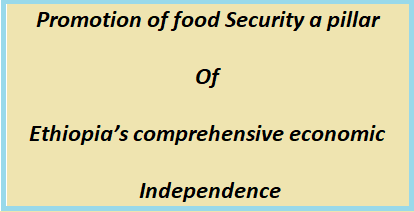
In a ceremony hosted by the United Nations Food and Agriculture Organization in Rome, Italy two weeks back, Prime Minister Abiy Ahmed has been awarded the prestigious FAO Agricola Medal, according to the organization, for his vision, leadership and commitment to food security and nutrition as well as the pursuit of innovative solutions in wheat self-sufficiency in the context of fast-changing and challenging circumstances. The author of this article is therefore motivated to share some ideas on the issue at hand.
Similar award was also issued to Hailemariam Desalegn some six years back. This indicates that the implementation of food security programs is decisive not only for the promotion of food self-reliance for Ethiopia but also for the entire economic growth of the country.
In another development, Prime Minister Abiy Ahmed and First Lady Zinash Tayachew and other government officials inspected the progress underway in the construction and Development of a massive irrigation scheme built on Wabe Shebele River in Shebele Zone Berano District.
The official definition of food security has been provided by the Food and Agriculture Organization (FAO) of the United Nations. According to the FAO, food security exists when all people, at all times, have physical, social, and economic access to sufficient, safe, and nutritious food that meets their dietary needs and food preferences for an active and healthy life.
How does Ethiopia feature in terms of developing food security in the country?
Food self-sufficiency and food security are crucial issues for Ethiopia, given its large population, agricultural-based economy, and vulnerability to recurring droughts and other environmental challenges.
Agriculture is the backbone of Ethiopia’s economy, employing a majority of the population and contributing significantly to the country’s GDP. However, Ethiopia’s agriculture is predominantly rain-fed and vulnerable to climatic variability, which poses challenges to food production and security.
The Ethiopian government has implemented various initiatives and strategies to improve food self-sufficiency and enhance food security. These include agricultural development programs, investments in irrigation infrastructure, promotion of improved farming practices, and support for smallholder farmers through subsidies, credit facilities, and extension services.
Ethiopia has been promoting crop diversification to enhance resilience to climate change and improve food security. Efforts to diversify crops beyond traditional staples like teff, maize, and sorghum include promoting high-value crops such as fruits, vegetables, oilseeds, and pulses, which can contribute to dietary diversity, income generation, and nutrition security.
Ethiopia has been investing in water management infrastructure, including dams, reservoirs, and irrigation schemes, to enhance water availability for agricultural production, especially during dry seasons. These investments aim to increase crop yields, stabilize food production, and mitigate the impact of droughts and water scarcity on food security.
Given Ethiopia’s susceptibility to climate-related shocks and natural disasters, resilience-building measures are essential for ensuring food security. These include early warning systems, disaster preparedness, risk mitigation strategies, and social safety nets to support vulnerable populations during periods of food insecurity and crisis.
Despite progress in improving food self-sufficiency at the national level, there are significant regional disparities in food security within Ethiopia. Certain regions, particularly those prone to drought and conflict, face chronic food insecurity and require targeted interventions to address underlying causes such as poverty, land degradation, and limited access to resources.
Enhancing market access and improving food distribution systems are critical for ensuring food availability and affordability, especially in remote and rural areas. Investments in transportation infrastructure, market facilities, storage capacities, and market information systems can facilitate the efficient movement of food commodities and reduce post-harvest losses.
Achieving food security goes beyond ensuring an adequate supply of calories; it also entails addressing issues of nutrition security and dietary quality. Ethiopia’s food security efforts increasingly focus on promoting nutrition-sensitive agriculture, improving access to diverse and nutritious foods, and addressing malnutrition, particularly among women and children.
Measures to reverse the level of land degradation and create a source of income generation for food-insecure households through a focus on biological measures, such as re-forestation and land preservation. The National Green Legacy Initiative launched by Prime Minister Abiy four years back and the consequent Yelemat Trufat Program and more than 11 irrigation schemes that are currently under construction or those completed certainly show the level on which the government has prioritized food security.
Moreover, water harvesting and the introduction of high-value crops, livestock and agro-forestry development have been conducted in various parts of the country.
Agriculture is considered to be the starting point for initiating the structural transformation of the economy. Because of this, agricultural development-led industrialization (ADLI) has been pursued as a major policy framework since 1991. ADLI assists the development of agriculture and helps expand markets for domestic production leading to increased incomes for small holders.
High population growth rates continue to undermine Ethiopia’s ability to be food secure and provide effective education, health and other essential social and economic services. The central elements of the policy focus on a multi-sector approach, improving family planning services and expanding education.
HIV/AIDS is a formidable challenge to the pursuit of food security in Ethiopia as it reduces and debilitates the productive population and society as a whole. The government has put in place a national policy and countrywide program for the whole population to control and reduce the spread of the disease.
Women have a substantive productive role in the rural sector, including participation in livestock maintenance and management, crop production, and the marketing of rural produce. Integration of gender perspectives in the design and implementation of economic and social policies, programs and projects is considered central to the national food security strategy.
This is critical to the pursuit of food security and economic development generally. Development depends on the appropriate and sustainable use of the environment and the management of natural resources. Given the high environmental degradation in drought-prone and pastoral areas, environmental rehabilitation (soil and water conservation) is an essential element.
What are the approaches of the National Food Security Strategy and why are they important?
Ethiopia has made notable strides in improving food security and agricultural development over the years, although challenges persist.
The country has implemented various initiatives to enhance agricultural productivity, including the adoption of improved seeds, modern farming techniques, and sustainable land management practices. These efforts have contributed to increased crop yields and diversified agricultural production.
Nation has invested in the development of irrigation infrastructure to mitigate the impact of erratic rainfall patterns and droughts. Large-scale irrigation projects, including the Grand Ethiopian Renaissance Dam (GERD) and small-scale irrigation schemes, have expanded access to water for agricultural purposes, boosting crop production and resilience to climate variability.
Smallholder farmers play a significant role in Ethiopia’s agriculture sector, accounting for the majority of food production. Government policies and programs have focused on supporting smallholder farmers through access to credit, extension services, market linkages, and input subsidies to improve their productivity and livelihoods.
Ethiopia has taken steps to improve food distribution systems and enhance market access for farmers, traders, and consumers. Investments in rural infrastructure, transportation networks, and market facilities have facilitated the movement of food commodities from surplus to deficit areas, reducing food price volatility and improving food availability.
Ethiopia has implemented community-based nutrition programs to address malnutrition and improve dietary diversity among vulnerable populations, particularly women and children. These programs focus on promoting breastfeeding, micronutrient supplementation, nutrition education, and the cultivation of nutrient-rich crops to combat malnutrition and stunting.
Given Ethiopia’s vulnerability to recurrent droughts and climate-related shocks, resilience-building measures and disaster preparedness efforts are integral to ensuring food security. Early warning systems, social safety nets, emergency food assistance programs, and investments in drought-resistant crops help mitigate the impact of food crises and support communities during times of hardship.
Ethiopia’s government has demonstrated a strong commitment to addressing food security challenges through national development plans, strategies, and partnerships with international organizations, donors, and development partners. Collaborative initiatives aim to mobilize resources, build institutional capacity, and implement innovative solutions to improve food security outcomes.
While Ethiopia has made significant progress in enhancing food security, persistent challenges such as climate variability, land degradation, population growth, and poverty continue to pose obstacles to sustainable development. Addressing these challenges requires continued investment, policy coherence, and multisector collaboration to build a resilient and inclusive food system that ensures access to nutritious food for all Ethiopians.
Apart from the above mentioned achievements and challenges, Ethiopia still needs to resolve other forms of challenges that directly or indirectly affect the countries food security initiatives.
The writer is of the opinion that inflation on food prices is already a challenge followed by mismanagement of the distribution of agricultural inputs like fertilizers and selected seeds.
On the other hand, despite their potentials in contributing to the promotion of food security in the country, the extent to which microfinance institutions in Ethiopia are up to their expectations is still not clear. Food security is not only a matter of producing food but having access to food from markets. The current price of 100 kilos of teff has surpassed 10,000 birr and a piece of enjera now is birr 30. What kind of contribution can the microfinance institutions provide to potential clients in supporting them to have access to food? The author hopes they may have the answer.
Food security cannot be attained in Ethiopia by a single handed effort of the government. Civil society organizations and international NGOs operating on food security at household level need to accelerate their efforts, particularly in drought prone zones of the country.
Ethiopia is on track in attaining food security in the shortest possible time but the public needs to contribute their part by extensively participating on urban agriculture and backyard gardening in rural and outback areas.
BY SOLOMON DIBABA
THE ETHIOPIAN HERALD WEDNESDAY 6 MARCH 2024





